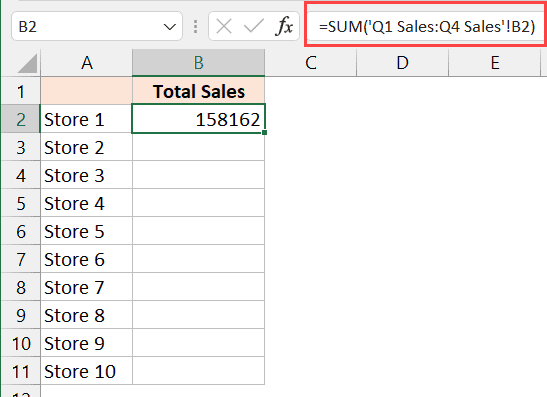5 Ways to Link and Sum Data Across Excel Sheets

Managing large datasets in Excel often requires the ability to link and summarize data across multiple spreadsheets. Whether you're an accountant, a data analyst, or just someone trying to organize a large volume of information, Excel offers several sophisticated techniques to streamline this process. Here are five essential methods to connect and consolidate your data effectively.
1. Using External References (3D References)

External references, also known as 3D references, allow you to refer to cells across different worksheets within the same workbook. This method is particularly useful for consolidating similar data from multiple sheets.
- Start by selecting the cell where you want to display the linked data.
- Type the formula, using square brackets to reference the workbook and an exclamation mark to reference the sheet. For example:
=Sheet1!A1or=[Budget.xlsx]January!A1. - This formula will pull data from cell A1 in Sheet1 or January in Budget.xlsx respectively.
📌 Note: Ensure that the workbook names and sheet names are spelled correctly, including spaces and case sensitivity.
2. Consolidating Data via PivotTable

PivotTables are incredibly powerful for summarizing, analyzing, exploring, and presenting data from various sheets or even separate workbooks.
- Click on any cell within your dataset to initiate the PivotTable wizard.
- Choose "Multiple consolidation ranges" under 'Where is the data that you want to analyze?'
- Select 'I will create the page fields' if you want to filter by sheet names.
- Select the data ranges from each sheet you want to consolidate, then click 'Add' for each.
Excel will then create a new sheet with a PivotTable that allows you to analyze and summarize data from all added ranges as if they were one.
3. The INDIRECT Function

The INDIRECT function can dynamically reference cells or ranges from different worksheets or workbooks, offering flexibility in linking data.
- Use the formula:
=INDIRECT("'Sheet"&A1&"'!B2"), where A1 contains a sheet number or name. - This formula will return the value from cell B2 in the sheet named in A1.
📝 Note: The INDIRECT function can be volatile, which means it recalculates for every change in the worksheet, potentially slowing down large workbooks.
4. VLOOKUP or XLOOKUP Across Sheets

When dealing with related datasets split across different sheets, using VLOOKUP or the more recent XLOOKUP can be beneficial for pulling corresponding information.
- In the sheet where you want the lookup result, type the formula:
=VLOOKUP(A1,Sheet2!A:B,2,FALSE). - This will search for A1's value in the first column of the specified range in Sheet2 and return the corresponding value from the second column.
XLOOKUP provides more flexibility with default return values for errors and has a simpler syntax: =XLOOKUP(A1,Sheet2!A:A,Sheet2!B:B,"Not Found",0).
5. Data Consolidation Feature

Excel's data consolidation feature can combine data from multiple ranges, even if they are in different sheets or workbooks, into a single master sheet.
- Go to the 'Data' tab, then select 'Consolidate' under the 'Data Tools' group.
- Choose the function you want to use for consolidation (Sum, Count, Average, etc.).
- Add ranges from different sheets or workbooks by clicking 'Add' for each range.
- You can also choose to create links to the source data for dynamic updates.
This feature is particularly useful when dealing with repetitive data from different periods or sources.
Linking and summarizing data across Excel sheets can significantly improve your workflow, saving time and reducing errors when dealing with large or complex datasets. By mastering these techniques, you can enhance the accuracy of your analyses, improve data consistency, and simplify reporting processes. These methods not only boost productivity but also make your data management in Excel more intuitive and efficient. Whether you're looking to track expenses, manage inventory, or compile reports from various departments, these Excel functions can help transform your raw data into insightful, actionable information.
What’s the difference between VLOOKUP and XLOOKUP?

+
VLOOKUP is limited to looking up from left to right, requires the lookup value to be in the first column of the range, and can’t return references. XLOOKUP can look up values in any direction, return entire rows or columns, and includes default value handling for errors.
Can I use these techniques in Google Sheets?

+
Many of these functions like VLOOKUP, XLOOKUP, INDIRECT, and PivotTables are available in Google Sheets, though some syntax or features might differ slightly. Google Sheets has its unique functions like QUERY, which can also consolidate data from multiple sheets.
How can I avoid #REF! errors when using linked data?

+
Ensure that the referenced sheets and cells exist and that their names are correct. Use the INDIRECT function carefully, as it can cause errors if the referenced cell changes or if it’s deleted. Also, avoid using #REF! in formulas unless you’re intentionally referencing a non-existent or deleted cell.